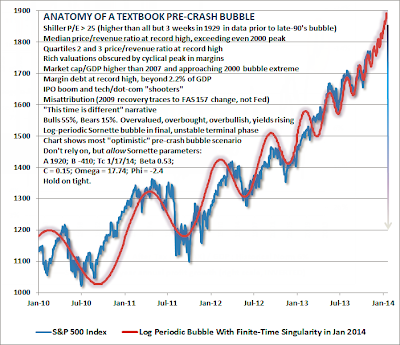Courtesy of Mish.
John Hussman’s last three weekly emails have been outstanding. Let’s take a look at a couple short snips from the first two articles and then a longer snip from his letter to the Fed.
Textbook Pre-Crash Bubble
November 11: Textbook Pre-Crash Bubble by John Hussman
Hussman: “The problem with bubbles is that they force one to decide whether to look like an idiot before the peak, or an idiot after the peak.“
This is exactly how I have felt for two years running. It reminds me of 1999-2000 when tech stocks put on that last big rally. Avoiding a bubble is incredibly hard to do, and this one has been exceptional.
Here is a of chart from the article with Hussman’s comments.
Though I don’t believe that markets follow math, it’s striking how closely market action in recent years has followed a “log-periodic bubble” as described by Didier Sornette (see Increasingly Immediate Impulses to Buy the Dip).
A log periodic pattern is essentially one where troughs occur at increasingly frequent and increasingly shallow intervals. Frankly, I thought that this pattern was nearly exhausted in April or May of this year. But here we are. What’s important here is that the only way to extend that finite-time singularity is for the advance to become even more vertical and for periodic fluctuations to become even more closely spaced. That’s exactly what has happened, and the fidelity to the log-periodic pattern is almost creepy. At this point, the only way to extend the singularity beyond the present date is to envision a nearly vertical pre-crash blowoff.
At this horizon, even “buy-and-hold” strategies in stocks are inappropriate except for a small fraction of assets. In general, the appropriate rule for setting investment exposure for passive investors is to align the duration of the asset portfolio with the duration of expected liabilities. At a 2% dividend yield on the S&P 500, equities are effectively instruments with 50-year duration. That means that even stock holdings amounting to 10% of assets exhaust a 5-year duration. For most investors, a material exposure to equities requires a very long investment horizon and a wholly passive view about market prospects.
Hugh Hendry Throws In Towel
On November 22, InvestmentWeek reported long-time bear Hugh Hendry threw in the towel. ‘I can’t look at myself in the mirror’: Hendry reveals why he has turned bullish
Speaking at Harrington Cooper’s 2013 conference, Hendry said he is no longer fighting the “two-way feedback loop” which is continuing to boost risk assets.
“I can no longer say I am bearish. When markets become parabolic, the people who exist within them are trend followers, because the guys who are qualitative have got taken out. I have been prepared to underperform for the fun of being proved right when markets crash. But that could be in three-and-a-half-years’ time.”
…




